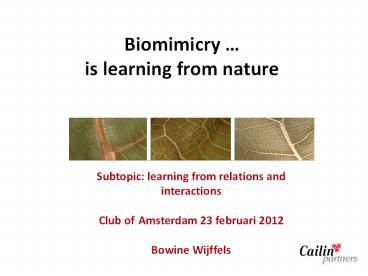Biomimicry - PowerPoint PPT Presentation
Title:
Biomimicry
Description:
Biomimicry = learning from nature an ecology of mind On a individual level (Biomimicry of behaviour, structure and form). On a level of groups and species (teams ... – PowerPoint PPT presentation
Number of Views:374
Avg rating:3.0/5.0
Title: Biomimicry
1
Biomimicry is learning from nature
Subtopic learning from relations and
interactions Club of Amsterdam 23 februari
2012 Bowine Wijffels
2
Bowine Wijffels
- Consultant learning for sustainable development
and environmental education. - Trainer and former teacher biology/geography
- Specific interest patterns of interaction
3
Real time business challenges
- The World is changing.
- Economic recession and loss of stability
- Rapid market changes and quick cycles
- Environmental and social instability
- Open source, new media, networks and cooperations
- Todays vocabulary (in respons)
- Adaptive Agility Resilience - Networking
- Learning organisation Interconnection
- Sustainable development.
4
Biomimicry learning from nature
- an ecology of mind
- On a individual level (Biomimicry of behaviour,
structure and form). - On a level of groups and species (teams, family,
colleagues). - On ecosystem level (organisations, cities,
communities).
5
Ad 1 Fysical and individual (source
biomimicry.org)
cleaning a surface
housing
Using effective tools
get a grip
6
Ad 2 Coorperation in groups
Ants teamwork in bridging the gap
Bees group communication about resources
Birds temporary and shared leadership
7
Accepted leadership
- A leader is accepted by the group when the
leader - Is smart enough to lead the way.
- Is social enough to take care of the individuals
in the group. - Chimpansee politics - Frans de Waal
- De natuurlijk leider Mark van Vugt
8
Sustainable principles of life
- Basic principles
- Life creates conditions for life
- Life develops and adapts.
- To understand these principles we need to
- Accept the idea of interdependancy and see the
whole (system).
9
System thinking?
- Observations
- Change one player and the achievements of the
whole team change. - The loss of one member of the family has an
impact on all relationships. - Add just a little more fish food and the pond
turns green. - One organ is not functioning and the whole is
sick. - We only know that we are part of a system when
things are changing and moving
10
Ad 3 learning from natural systems
A variety of simple and complex systems
11
Characteristics of living (eco) systems
- Basic ingredients of systems are
- Elements (physical parts)
- Connections (the interactions)
- Function (purpose)
- A system is more than the sum of the parts
interaction is vital - The system purpose is usually to sustain or
survive (and every function is focussed on that). - If it dies, it loses its system-ness.
12
Why are natural (eco)systems so different?
- De first time the word ecosystem was used by the
- English botanist A.C. Tansley, in 1935.
13
Because this is how they operate
- Optimal use of nearby resources (sun, minerals,
water or lack of these resources). - External cycli are fully integrated (cycli like
day and night, dry and wet, tide, seasons.). - It is stable and responds to external disturbance
(stability through diversity and flexibility). - No central management but small teams and
transparant communication (action and reaction
based).
14
Natural systems are stable because they are
resilient
- Engineering (operation) resilience
- The extent to which the system can respond to
changes (back in balance). - Ecological resilience
- The extent to which the system can change into
another system (new balance).
15
Living system thinking
- Characteristics
- When living systems want to get stronger, they
connect to more living things (diversity). - Living systems grow in chaos and are self
organising. - Nature makes its most important connection at
root level (underground). - You cant change a living system, all you can do
is disturb it. - The best disturbances challenge the equilibrium
and assumed order of the system. - If we can re-engineer it, its probably already
dead! - www.tipuake-org.nz
16
Model for organic leadership and innovative
organisations
17
7 lessons for leaders in system change
- To promote system change, foster community and
cultivate networks. - Work at multiple levels of scale (Oakland
strategy) - Make space for self organisation.
- Seize breakthrough opportunities when they arise.
- Facilitate change (but give up the idea that you
can direct change). - Assume that change is going to take time.
- Be prepared to be surprised.
- www.ecoliteracy.org
18
Related initiatives
- Blue Economy Alliance
- The Natural Step
- Ellen MacArthur Foundation
- Biomimicry 3.8
- C2C
- Circle Economy
- Living system thinking
- Anecologymind (5th of March)































